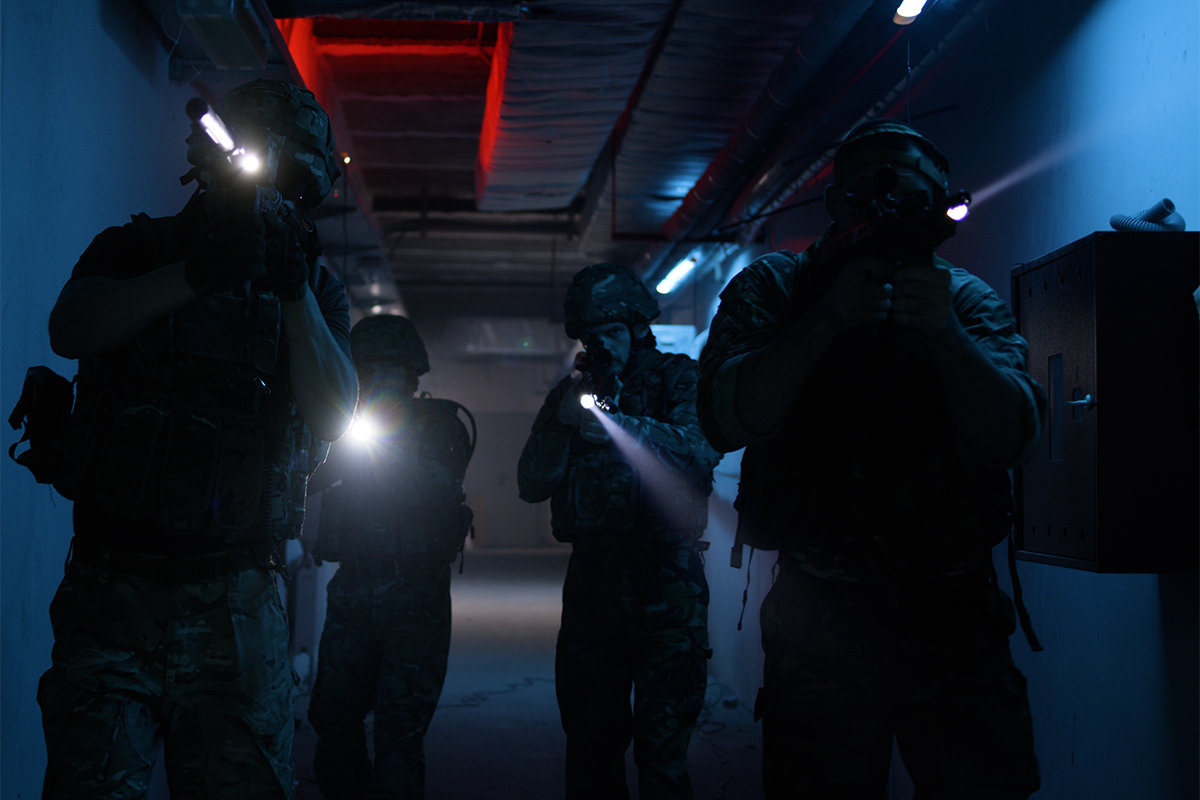Built for battle, ready for anything
Tactical flashlights are purpose-built tools intended for specific applications that involve high-stress scenarios. These
flashlights are engineered to meet the specific needs of military, law enforcement, security personnel, and outdoor enthusiasts who require a reliable and durable light source in challenging environments. A tactical flashlight is not an average flashlight that one might use for general purposes. It is designed with a set of features and functionalities that cater to the unique requirements of tactical scenarios. These features go beyond what is typically found in a standard flashlight. The increasing popularity of tactical flashlights can be attributed to their versatility, self-defense features, emergency preparedness appeal, advancements in technology. Tactical flashlights are versatile tools that find applications beyond professional use. As awareness about the specific features and benefits of tactical flashlights grows, more consumers are choosing them over traditional flashlights. They are favored by outdoor enthusiasts, campers, hikers, and individuals who value a reliable and robust flashlight for various activities.
Typical features of tactical flashlights
Tactical flashlights come with a set of features that distinguish them from regular flashlights and make them well-suited for high-stress situations, military use, law enforcement, and outdoor activities.
Tactical flashlights are designed to be compatible with weapon mounts, allowing users to attach the flashlight to firearms or other weapons. This integration enhances target identification and aiming in low-light conditions. Many tactical flashlights have a crenelated or aggressive strike bezel around the head. This feature can be used for self-defense purposes or breaking glass in emergency situations. Tactical flashlights commonly feature a tail switch for easy one-handed operation. The tail switch may offer momentary-on or constant-on functionality, providing quick and easy access to light when needed. Pressure switches, which are often remote and attached to the weapon, enable hands-free control. The body of tactical flashlights often features textured or knurled surfaces to provide a secure grip. This ensures that users can maintain control of the flashlight even in wet or slippery conditions.
Tactical flashlights are designed to produce high-intensity light. The high lumen output of tactical flashlights is vital for providing a bright and intense beam of light, which is instrumental in tasks such as target identification and situational awareness. This feature enhances the effectiveness and safety of law enforcement officers and military personnel in challenging and dynamic environments. Some military flashlights come with infrared (IR) capabilities, allowing users to operate in low-light or no-light conditions with the assistance of night vision devices. Tactical flashlights typically feature adjustable focus or zoom capabilities, allowing users to switch between a focused spotlight and a broader floodlight. This adaptability is useful for different tasks and scenarios. Many tactical flashlights offer multiple brightness levels and modes, such as low, medium, high, strobe, or SOS. This versatility allows users to adapt the flashlight to different scenarios and conserve battery life when maximum brightness is not required. The strobe function is a common feature in tactical flashlights, serving purposes such as disorienting potential threats, signaling for help, or attracting attention in emergency situations.
Tactical flashlights often prioritize energy efficiency, providing a longer battery life compared to traditional flashlights. This is essential, especially in situations where a reliable and long-lasting light source is required. Tactical flashlights may use common battery types like AA or CR123A, or they may feature
rechargeable batteries. The runtime (how long the flashlight can operate on a single set of batteries) is an important consideration.
Diverse applications
The combination of durability, portability, and powerful illumination makes tactical flashlights valuable tools in various situations. Tactical flashlights are primarily used by law enforcement officers (police, security personnel) and military personnel (soldiers, special forces). Tactical flashlights enhance situational awareness by providing reliable and powerful illumination in low-light or no-light conditions. Clear visibility is crucial for law enforcement and military personnel to assess situations, identify potential threats, and make informed decisions. Law enforcement officers often need to search for suspects, evidence, or navigate in low-light environments. Tactical flashlights facilitate effective searching, allowing officers to identify individuals, objects, or hazards in a timely and precise manner. Military personnel engage in various tactical operations, including raids, patrols, and missions in diverse environments. Tactical flashlights are vital tools for military professionals, aiding in navigation, target identification, and maintaining operational security during nocturnal or low-light operations. Security personnel use tactical flashlights during nighttime patrols to monitor premises and maintain visibility. The bright light can deter potential security threats. Tactical flashlights are important components of emergency preparedness kits. In power outages or other emergencies, they provide a reliable source of light for navigating and attending to immediate needs. In search and rescue missions, tactical flashlights help rescuers navigate challenging terrain, locate individuals, and signal for attention. The high-intensity illumination is valuable in low-light or nighttime scenarios. Campers, hikers, and backpackers rely on tactical flashlights for nighttime activities. These flashlights assist in setting up campsites, navigating trails, and providing illumination in the wilderness.
The adoption of LED technology in tactical flashlights significantly expands their capabilities. The efficiency of LEDs contributes to maximized battery life and longer operational times. This is crucial in tactical situations where a reliable and long-lasting light source is essential. Despite their energy efficiency, LEDs can produce bright and intense illumination. Tactical flashlights equipped with
high power LEDs are capable of delivering a powerful and focused beam of light, making them effective tools for various applications. LEDs are solid-state devices with no fragile filaments or glass bulbs. This inherent durability makes LED tactical flashlights more resistant to shocks, impacts, and vibrations, ensuring reliability in demanding conditions. The compact nature of LEDs allows for the creation of streamlined and portable designs in tactical flashlights. This contributes to improved portability, ease of carry, and overall user convenience, which are essential considerations in tactical and emergency use. LED tactical flashlights provide instantaneous illumination without the warm-up time required by some other light sources. This instant on/off capability is crucial in tactical situations where quick and reliable lighting is essential. LED technology enhances the functionality of tactical flashlights by enabling multiple lighting modes. This versatility caters to a range of scenarios, from tactical operations to emergency situations, and allows users to customize the flashlight's performance based on their preferences and specific needs.
Design and engineering
The design and engineering of LED tactical flashlights aim to create reliable, durable, and versatile tools that meet the demanding requirements of professionals in law enforcement, military, and other tactical settings. Tactical flashlights often leverage
high power LEDs to enhance their performance. High-power LEDs exhibit characteristics such as high lumen outputs, high flux density, and limited lumen depreciation over their lifespan. The operational life of high-power LEDs is closely tied to the ability of the lighting system to manage
heat dissipation. The prioritization of thermal management in tactical flashlights is driven by the goal of ensuring the long life and consistent performance of high-power LEDs. By effectively handling heat generated during operation, these flashlights can provide reliable illumination over an extended period. In addition to preserving LED life, an effective thermal management design contributes to user comfort. The overall design of an LED tactical flashlight is intentionally crafted to include considerations of shape, grip, and user interface to actively prevent thermal discomfort. Tactical flashlights are built to be exceptionally durable, often using materials like aerospace-grade aluminum, stainless steel, or reinforced polymers. This construction ensures the flashlight can withstand rough handling, impacts, and challenging environmental conditions. These flashlights are designed to withstand impact and shock, ensuring they remain operational after being dropped or subjected to harsh conditions. These flashlights are often designed to be water-resistant or waterproof, ensuring functionality in various weather conditions, including rain or submersion in water. Despite their enhanced features, tactical flashlights are often compact and portable, allowing professionals to carry them easily on duty belts, vests, or in pockets. The portability of these flashlights ensures that they can be readily accessible when needed, contributing to the agility and responsiveness of law enforcement and military personnel.
Battery
The use of high-capacity batteries complements the performance of LED tactical flashlights by ensuring extended illumination, reducing the need for frequent battery changes, and enhancing overall portability. In professional and tactical applications, where reliability and performance are critical, the use of high-capacity batteries is particularly advantageous. Law enforcement, military personnel, and first responders benefit from flashlights that can deliver consistent and powerful illumination throughout their tasks. LED tactical flashlights, especially those equipped with high-power LEDs, require a reliable and sustained power source to deliver bright and intense illumination. High-capacity batteries meet this requirement by providing ample energy to the flashlight. The use of high-capacity batteries reduces the frequency of battery changes or recharges. This is beneficial in scenarios where users rely on the flashlight for extended periods without easy access to replacement batteries or charging outlets. LED tactical flashlights can be designed to accommodate both disposable and
rechargeable batteries. Rechargeable batteries can be designed to be more compact and lightweight compared to equivalent disposable batteries, contributing to a more streamlined and portable flashlight design. The rechargeable nature allows for a built-in charging mechanism or port in the flashlight, eliminating the need for external chargers and making the flashlight more self-contained.
Control circuitry
Control circuitry is a fundamental and integral part of LED tactical flashlights. It governs the operation, power management, user interface, and protection features. LED tactical flashlights often feature multiple modes or settings, such as different brightness levels, strobe functions, or special modes. Control circuitry is responsible for regulating and controlling these various modes, allowing users to adjust the flashlight's output based on their needs. Control circuitry plays a critical role in managing the power supply to the LEDs. It ensures that the power delivered to the LEDs is controlled, preventing issues like overloading and optimizing energy efficiency. The user interface of the flashlight, including buttons, switches, and modes, is governed by the control circuitry. This is what allows users to turn the flashlight on or off, switch between modes, and potentially access additional features like strobe or SOS functions. Many LED tactical flashlights come with memory functions that remember the last-used mode or brightness level. Control circuitry facilitates mode selection and ensures that the flashlight retains user preferences, enhancing convenience and user experience. Control circuitry may include protective features to prevent damage to the LEDs or other electronic parts. This can include overcurrent protection, thermal management, and low-voltage protection.







































